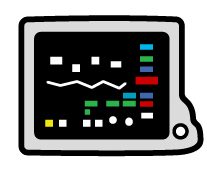The screen near your child's bed is called a monitor. It displays information such as: heart rate, heart rhythm, blood pressure, oxygen and carbon dioxide levels. Sometimes it is used to show pressures in the brain. Devices from your child's body send information to the monitor.

Blood pressure cuff
A blood pressure ‘cuff' is placed on your child's arm. It sends blood pressure readings to the monitor.
Oxygen saturation probe
This device clips onto a finger or toe. It has a red light. It measures the oxygen levels in the blood. Sometimes these readings get called “sats”.
Electrocardiogram (ECG)
Several electrodes are attached to your child's chest with stickers. These electrodes take electrical readings from the heart and send them to the monitor.
Arterial line
This is a plastic tube inserted into an artery to measure pressures. The artery usually chosen is in the wrist. It can also come from an artery around the neck area.
Central venous catheter
This is a plastic tube inserted into a large vein. The vein usually chosen for this is in the chest, neck or groin area. It can be used to measure pressures in vessels around the heart.
Alarms will often be heard from monitors in PICU. It can be stressful hearing alarms if you are not used to them. Please know that staff are highly trained to know what to do for each alarm.
Sometimes alarms will occur because of your child's movement or if one of the device stickers comes loose. Please ask your nurse about the alarms if you are worried.
This topic was reviewed by a paediatric intensive care medicine specialist in July 2022.